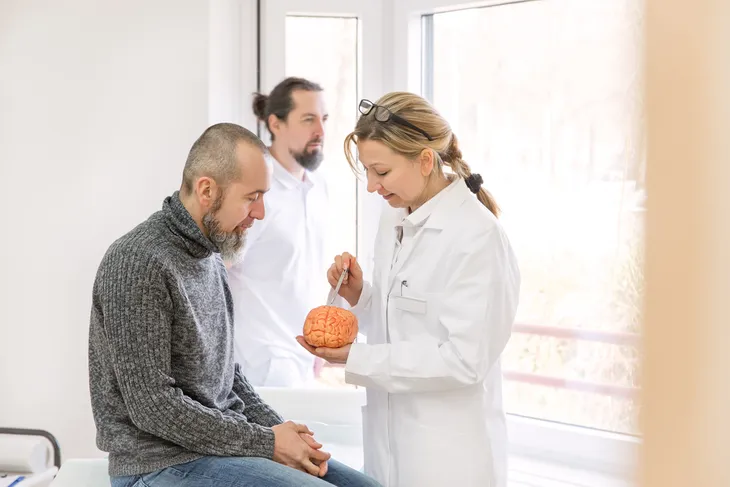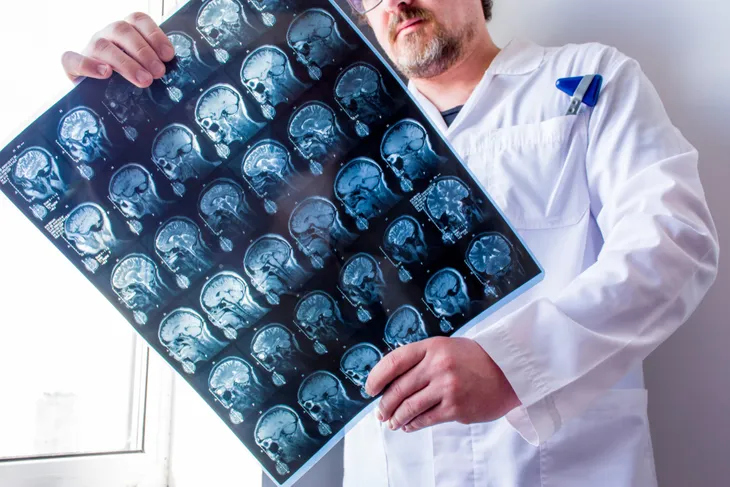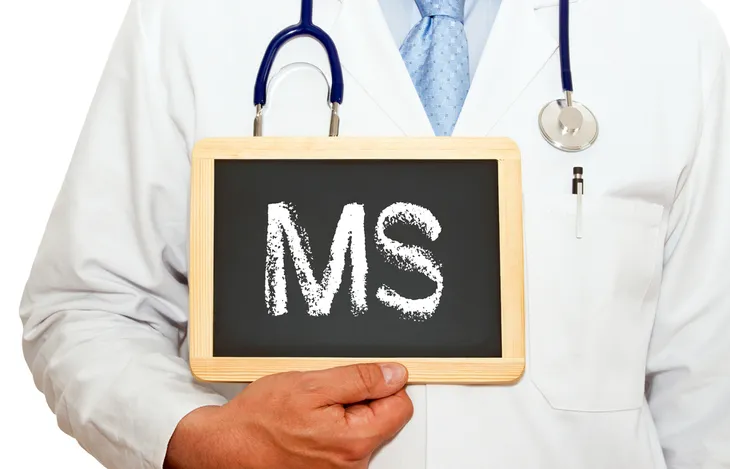- Multiple sclerosis (MS) is an autoimmune disease in which the body begins to attack itself, eventually impacting the brain, spinal cord and eyes.
- MS presents differently in everyone, making it harder to diagnose early on.
- Some individuals will have mild symptoms their whole life, while others will progress through all four stages of MS: CIS, RRMS, SPMS and PPMS.
- There is currently no cure for MS, and treatment focuses on reducing the frequency and severity of symptoms.
Multiple sclerosis (MS) is a serious neurological condition that is considered progressive — meaning the symptoms of the disease may get worse with time. Some patients diagnosed with MS eventually progress through all four known stages of the illness.
Today, MS remains a condition without a cure, but a lot of funds are being spent on research in the hopes of finding a cure. The National Multiple Sclerosis Society reported they received $41.7 billion in 2020 to fund their medical research.
Treatment focuses on helping patients recover quickly after a flare-up and manage their symptoms as they transition through the stages of multiple sclerosis.
What Is Multiple Sclerosis?
Multiple sclerosis is a chronic autoimmune illness that impacts the central nervous system, usually including the brain, spinal cord and optic nerves. People with MS may have problems with vision, muscle control, balance and other standard body functions.
Everyone who has multiple sclerosis experiences it differently. While this is considered a progressive, chronic disease, some only experience mild symptoms.
How Prevalent Is MS?
Multiple sclerosis didn’t officially get a title until the 1800s. Jean-Martin Charcot, a famous neurologist, lectured on the symptoms of MS and gave it a name in 1868.
In 2020, a report from 115 countries covering 87% of the global population reported that there are now 2.8 million people globally living with MS. This number has been rising in every region worldwide since 2013. It’s unclear why the number is increasing — it could be due to better data collection, global population growth, improved diagnosis or the fact that people with MS now live longer.
Women are twice as likely to be diagnosed with multiple sclerosis as men. The average age for diagnosis is 32, although the condition can present itself in children and teenagers.
A 2017 study reported that over 913,000 Americans have multiple sclerosis, a number that doubled since a previous count in 1975.
What Is the Cause of Multiple Sclerosis?
Unfortunately, the cause of MS is still unknown. Multiple sclerosis is an autoimmune disease where the body’s immune system attacks itself. With MS, the immune system destroys myelin — a fatty, insulating layer that forms around the nerves. Myelin protects nerve fibers in the brain and spinal cord. This explains why, as MS begins to attack the body’s supply of myelin, it results in complications with the brain, spinal cord and basic movements.
As the body begins its attack, the myelin layer becomes inflamed in small patches that look like lesions. A diagnostic test for multiple sclerosis can include an MRI scan looking for these lesions.
These patches of inflamed lesions can prevent the typical messages that travel along the nervous system. The messages can be slowed down, jumbled, sent the wrong way, or stopped from going through. When this happens, the typical symptoms of MS begin to show.
When the inflammation subsides, it can result in scarring of the myelin layer, leading to sclerosis. Additionally, if the body frequently attacks the myelin layer, permanent damage can eventually occur in the underlying nerves.
Researchers and scientists suspect that the cause of MS is a combination of genetics and environmental factors. Today, research is being done in a few areas to determine the root causes of MS:
- Immunology
- Epidemiology
- Genetics
- Infectious agents
What Are the First Signs of Multiple Sclerosis?
Multiple sclerosis is the kind of condition that presents itself differently in each person. The symptoms that one person may experience may never be experienced by another with MS. As a result, there’s no exact list of early signs of multiple sclerosis.
The following list includes early signs experienced by some individuals with MS:
- Vision problems
- Fatigue
- Numbness and tingling
- Difficulties with learning or problem-solving
- Loss of balance and dizziness
- Unusual sensations (severe itching, burning, stabbing or tearing pains)
- Stiffness or spasms
- Shakes or tremors
- Bladder problems
- Bowel problems
- Sexual problems
- Speech problems
It should be noted that having one, some or all of these symptoms is not a guaranteed diagnosis for multiple sclerosis — they could be symptoms of other conditions as well. Additionally, these symptoms may show up and go away for several months or years before returning. Most people who are eventually diagnosed with MS report first seeing signs between 20-40 years old.
What Are the Four Stages of Multiple Sclerosis?
There are four stages that have been identified with multiple sclerosis:
Stage 1: Clinically Isolated Syndrome (CIS)
The clinically isolated syndrome (CIS) is considered the first episode of neurological symptoms caused by inflammation and the attack on myelin in the central nervous system. By definition, the episode must last at least 24 hours to be considered a CIS.
Having a CIS does not necessarily result in a diagnosis of multiple sclerosis. Some people who have a CIS may never develop MS. However, if an MRI shows that another CIS has happened in the past, MS can be diagnosed. If a CIS isn’t accompanied by MS lesions on the brain or the presence of a previous CIS incident, the likelihood of developing MS is much lower.
Stage 2: Relapsing-Remitting MS (RRMS)
The second stage of MS is known as relapsing-remitting MS (RRMS). This stage is characterized by a standard pattern of worsening symptoms, recovery and reoccurrence. People with RRMS will have active periods of symptoms (relapses), after which they may experience a remission from all symptoms before another relapse occurs.
RRMS can be characterized as:
- Active: The patient has relapses and may show signs of new MRI activity over a short period
- Not Active: Symptoms aren’t showing for long periods
- Worsening: The relapses are becoming more common and some are becoming permanent
- Not Worsening: Relapses occur but without them getting more frequent, more severe or resulting in permanent disabilities
Approximately 85% of people with multiple sclerosis are first diagnosed with RRMS.
Stage 3: Secondary-Progressive MS (SPMS)
Secondary-progressive MS (SPMS) is the third stage of multiple sclerosis. Some individuals with RRMS eventually progress into the third stage of SPMS. This stage is defined by a worsening of neurologic functions over time. People may still experience relapses, but the remission is shorter and less frequent, and the symptoms worsen.
The progression into SPMS can happen within 10 years of the initial diagnosis.
Stage 4: Primary Progressive MS (PPMS)
The last stage of MS is the primary-progressive MS (PPMS) stage. It’s estimated that only 15% of people with MS are diagnosed with PPMS. This stage is characterized by worsening symptoms with no remission periods. There may be shorter periods where symptoms are stagnant, but the symptoms don’t improve.
MS is a unique condition in that it shows itself differently in everyone. The rate at which a person will progress through the stages is impossible to determine. Additionally, some people may never progress through all four stages. For example, someone with RRMS may never progress any further.
What Are the Treatment Options for Multiple Sclerosis?
As mentioned above, there’s no treatment option for multiple sclerosis yet. Instead, physicians focus on reducing the impact of symptoms. Currently, there are three categories of treatment for MS: abortive therapies, preventative therapies and symptomatic therapies.
Abortive Therapies
When an MS patient experiences a relapse of new or returning neurological symptoms for at least 24-48 hours, the primary treatment focuses on accelerating recovery. In minor relapses, a steroid might be used to shorten the flare-up.
Preventative Therapies
There are now several medications that can be used to treat the severity of MS symptoms and reduce the frequency of flare-ups. The medications are:
- Interferon beta-1a
- Interferon beta-1b
- Glatiramer acetate
- Natalizumab
- Mitoxantrone
Symptomatic Therapies
If multiple sclerosis symptoms worsen, patients can start to see an impact on their everyday functions. While medications can help to a degree, rehabilitation with physical therapists and occupational therapists is often necessary. MS patients may also need to seek support from psychiatrists, urologists and pain management specialists.
Living With Multiple Sclerosis
MS can be a challenging condition and can impact both patients and their loved ones. The most important step is to seek treatment. Medications and treatments can help individuals maintain the best quality of life possible.















